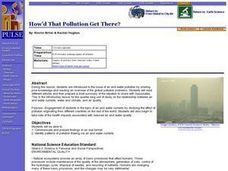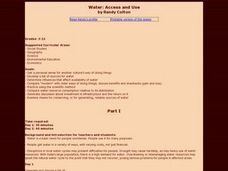Curated OER
Population Needs vs. Population Deeds
Pupils examine the recent population explosion of the world. After watching a demonstration on closed systems, they identify the role humans have on the depletion of natural resources and lowering the standard of living. To end the...
Curated OER
Population Density in the Ghettos
Students examine population density in Jewish ghettos. In this Holocaust lesson plan, students calculate population density of cities around the world using the provided information. Students then discuss the implications of high...
Curated OER
HIV/AIDS And Contemporary Population Dynamics
Students describe the spread and occurence of HIV/AIDS at multiple scales. They explain global and regional variations in the occurence of HIV/AIDS and explain the spread of HIV/AIDS in the United States.
Curated OER
Social Studies: Devastating Diseases
Students are able to critically read literature addressing historical data and answer relevant questions. They are able to formulate an opinion and support it using all knowledge documented and learned in this and previous lessons.
Advocates for Human Rights
Who are Immigrants?
What do Jerry Yang, Patrick Ewing, John Muir, Charlize Theron, Peter Jennings, and Saint Frances X Cabrini all have in common? They are all immigrants to the United States. Famous and not-so-famous immigrants are the focus of a resource...
Curated OER
Diversity
Eleventh graders research the meaning of diversity and human rights in various countries. For this Social Studies lesson, 11th graders reflect on the aspects that can negatively affect First Nations people, then select a country...
Curated OER
Environment: How'd That Pollution Get There?
Students examine how global wind and water patterns aid in the spread of worldwide pollution. In groups, they read articles about the domino effect of pollution and create posters displaying its journey. On blank world maps, students...
Curated OER
Zhuang: China's Largest Minority
Students, in groups, research Chinese ethnic minorities such as the Zhuang population. They identify the characteristics of different ethnic groups and consider the lives of ethnic groups worldwide.
Curated OER
Push/Pull Factors and Welsh Emigration
Students view and discuss short sections of movies that relate to immigration. Working in groups, students create a map that shows directions of internal migration in their assigned geographical area. Students review ads/booklets created...
Curated OER
Water: Access and Use
Young scholars get a personal sense for another culture's way of doing things. Develop a list of sources for water. Practice using the scientific method. Examine means for conserving, or for generating, reliable sources of water.
Curated OER
Homeless in our Community
Third graders explore homelessness in their local community. In this service project/social studies lessons, children research local areas where homeless people reside, discuss global acceptance and unity, and visit a local food bank.
Curated OER
Australia's Religious Diversity
Students identify major world religions and forms of spirituality and recognise the religious diversity of communities in Australia. They brainstorm for the definition of religion. Students brainstorm to come up with a list of religions.
Curated OER
Preparing for Drought
Middle schoolers study droughts in Oklahoma and list possible reasons for droughts. They form subcommittees to explore the drought problem and create plans for drought management and relief. They research five areas around the world...
National First Ladies' Library
Pandemics: The Swine Flu of 1918
Learners study pandemics through the investigational research of the 1918 swine flu. They apply the information by choosing a current virus and role-playing a member of the Centers of Disease Control (CDC).
PBS
Pbs Learning Media: Problems Facing Internally Displaced Persons Worldwide
Young scholars use video segments from the PBS series Women, War & Peace, as well as information from the Internal Displacement Monitoring Centre and the United Nations to learn more about internally displaced populations.














